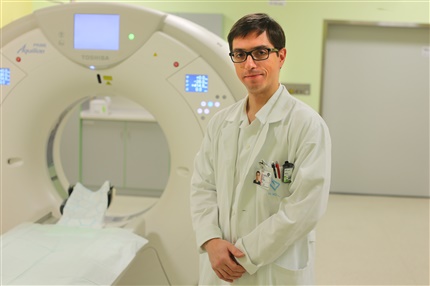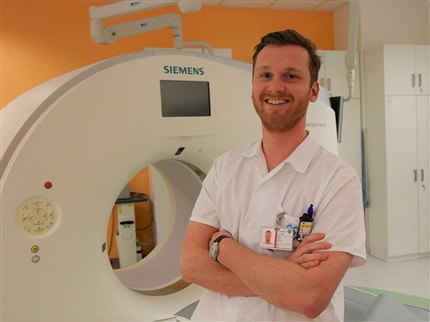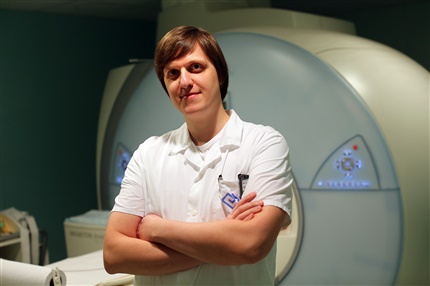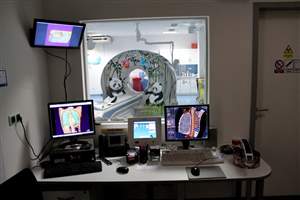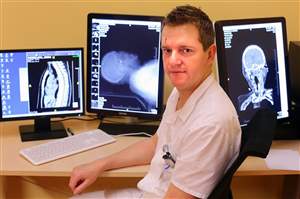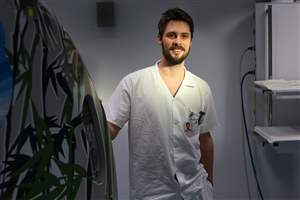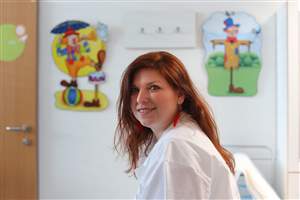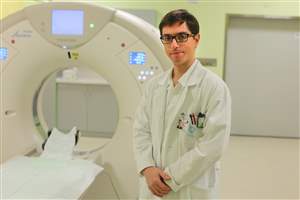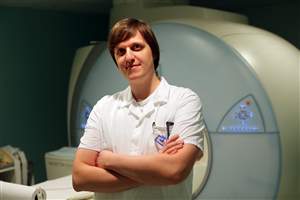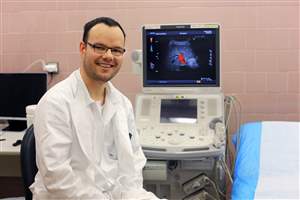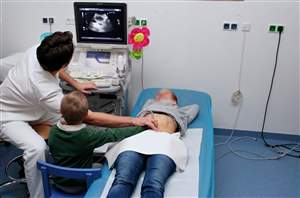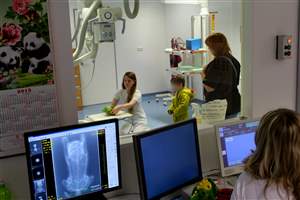A brief overview of the Specialized Center of Radiology and Diagnostic Imaging
Our center provides comprehensive diagnostic and treatment procedures for children and adults using radiology and various imaging methods. We are particularly proud of the new pediatric diagnostic center that was first opened in 2011 and ranks amongst the most advanced centers in Europe.
Annually, we perform more than 250.000 examinations and the number increases each year.
We cooperate with the vast majority of the departments in the hospital. Our center is divided into 12 departments – Bone diagnostics, Sciascopy and Sciagraphy department for adults, Interventional Radiology, Computed Tomography for adults, Magnetic Resonance Imaging for adults, Sonography for adults, Mammography and sonography of breast, Department of radiation physics, Pediatric sonography, Pediatric Magnetic Resonance Imaging, Department of pediatric computed tomography, and Pediatric conventional radiology.
How will your detailed schedule look like? What type of procedures, methods or treatment can you observe? Check what can you see by shadowing every member of the mentoring team.
Is this specialty placement ideal for you?
- Are you not sure which specialty attracts you the most? Would you like to choose a placement to gain experience from the ground up? Radiology and Diagnostic Imaging placement is a perfect choice for you. We cooperate with all of the departments, which require information about the patients – you will gain insight in various cases of both, adult and child patients. Before planning the surgery or providing specific treatment, everything begins right at this center – examinations from MRI through X-rays to sonography. You would hardly find another specialty with more diagnostic methods and a bigger variety of cases.
- If you know that healthcare profession is your future, you should undertake this placement. The great overview of human anatomy is something you will need daily, whether you are doctor, nurse, paramedics, physical therapist, midwife, or a dentist. As there is a lot of work with advanced devices, the placement is also suitable for future technicians in the healthcare field. Seeing the different cases of patient's health problems may help you a lot when searching for your way.
Let's take a closer look at the specialties…
We provide examinations for the entire hospital complex. Patients come to us for x-ray scans, sonography examinations, CT scans, MRI scans, vascular examinations, examinations of the digestive tract, examinations within pediatric radiology and we also perform interventional radiology.
At the Department of Bone Diagnostics and Outpatient Radiology we make about 100.000 sciagraphy and sciascopy examinations every year. We focus mainly on the bone diagnostic but we also perform essential x-ray examinations of our outpatient patients. We are also able to examine patients that cannot move thanks to the special imaging bed which doesn't require patients to position themselves. Our two digital radiography systems enable us to examine the whole spine and limbs within one exposition, one image. A lot of procedures are conducted directly in the ORs at the departments of traumatology, Spinal Surgery Specialized Center, Specialized Center of Orthopedics or Neurosurgery Specialized Center.
Adults in need of contrast examination of digestive system, bile ducts, uropoetic system, fistulography, lymphography, perimyelography, or non-vascular intervention can come to the Department of Sciascopy and Sciagraphy Radiology for Adults. Every year we perform more than 30.000 sciagraphy examinations.
The interventional radiology is performed in the Department of Interventional Radiology and is also known as the Department of Angiography. A majority of the procedures in this department are planned interventions due to findings on CT and MRI scans. Since the department has a hybrid operating room which is designed for combined surgeries, it allows us to perform surgeries in cooperation with vascular surgery. These procedures are typically implantations of stent grafts in patients with pectoral and abdomen aorta disorders. We also perform endovascular procedures.
The Department of Computed Tomography for Adults provides regular CT examinations such as CT scans of head, throat, chest, abdomen, small pelvic, limbs but also specialized CT examinations such as CT scans of heart, angiography, virtual colonoscopy, virtual bronchoscopy or dental CT scan. When taking care of patients before and after a lung transplant, our department cooperates closely with the Pulmonology Specialized Center and Surgery Specialized Center. We also perform interventional procedures. Annually, we take care of almost 20.000 patients.
Ultrasound examinations are conducted in the Department of Sonography for Adults. We examine abdomen, small pelvis within retroperitonea structures, throat organs, joint and soft tissues. We also perform duplex examinations and interventional procedures. Annually, thereare about 25.000 ultrasound examinations.
For women, we have a Department of Mammography and Sonography of Breasts. Patients are referred to us from our own hospital or other healthcare facilities. Yearly we provide about 30.000 mammography examinations.
Department of Pediatric Radiology provides about 14.000 examinations every year and almost 1.500 of them are specialized examinations of GIT diagnostics.
In 2012, 28 children died in the Czech Republic due to child abuse. Unfortunately, 55% of those children visited a doctor during the last month of their short life. We are deeply concerned with this matter and try to deal with this tragic part our work in the best way so as to prevent such cases. Therefore, our center has created a special protocol for imaging a child who is a suspected victim of child abuse.
Our center also organizes European radiology schools within European Ultrasound Association and European Society of Radiology. These lectures are held not only for doctors from Europe but also from other countries across the globe. We also participate in organization of Czech Radiology Congress.
Who do we take care of?
Our specialized center provides diagnostic examinations in the entire spectrum of radiology for both adults as well as children. The service runs 24/7. We conduct super consultant diagnostic examination and consultations for child oncology patients. We diagnose various inborn disorders and examinations of high-risk newborns. The examinations of inborn disorders of vascular system are performed by Doppler Sonography. In a cooperation with Neurology we provide treatment for stroke patients.
Our methods and procedures
Here are some of the methods and procedures that we performed in our specialized center:
- MRI – new possibilities to examine vessel, functional examination of heart, tractography,T2 relaxometry, examination by non-cooperating patients, spectroscopy
- Prenatal Ultrasound and MRI diagnostics
- In mammography and sonography we provide ductography, cyst puncture and core cut biopsy under ultrasound, biopsy using Vacora Biopsy System , pre-surgery localization by ultrasound
- Radiofrequency ablation and chemoembolization of metastasis on liver and lungs
- Implementation of aortal stent grafts, brain thrombectomy, subintimal recanalisation of peripheral arteries of lower limbs, treatment of acute and chronical deep vein thrombosis, treatment of vessel accesses for hemodialysis, insertion of translumbar catheters
- We treat brain malformations in children and adults
- We perform bile duct interventions, including implantation of absorbable stents, spondylo and vertebroplasty
- Radiology interventions under CT sciascopy
How does the usual schedule look like?
- Your stay in the hospital differs according to your mentoring team shifts in pediatric and adult departments, but the schedule of our department is rather a regular one. You are guaranteed to work at least 25 hours a week.
If you are not sure whether this choice is suitable for you, don’t hesitate to contact us. We will discuss your experience and motivation and come up with the best solution for you.



